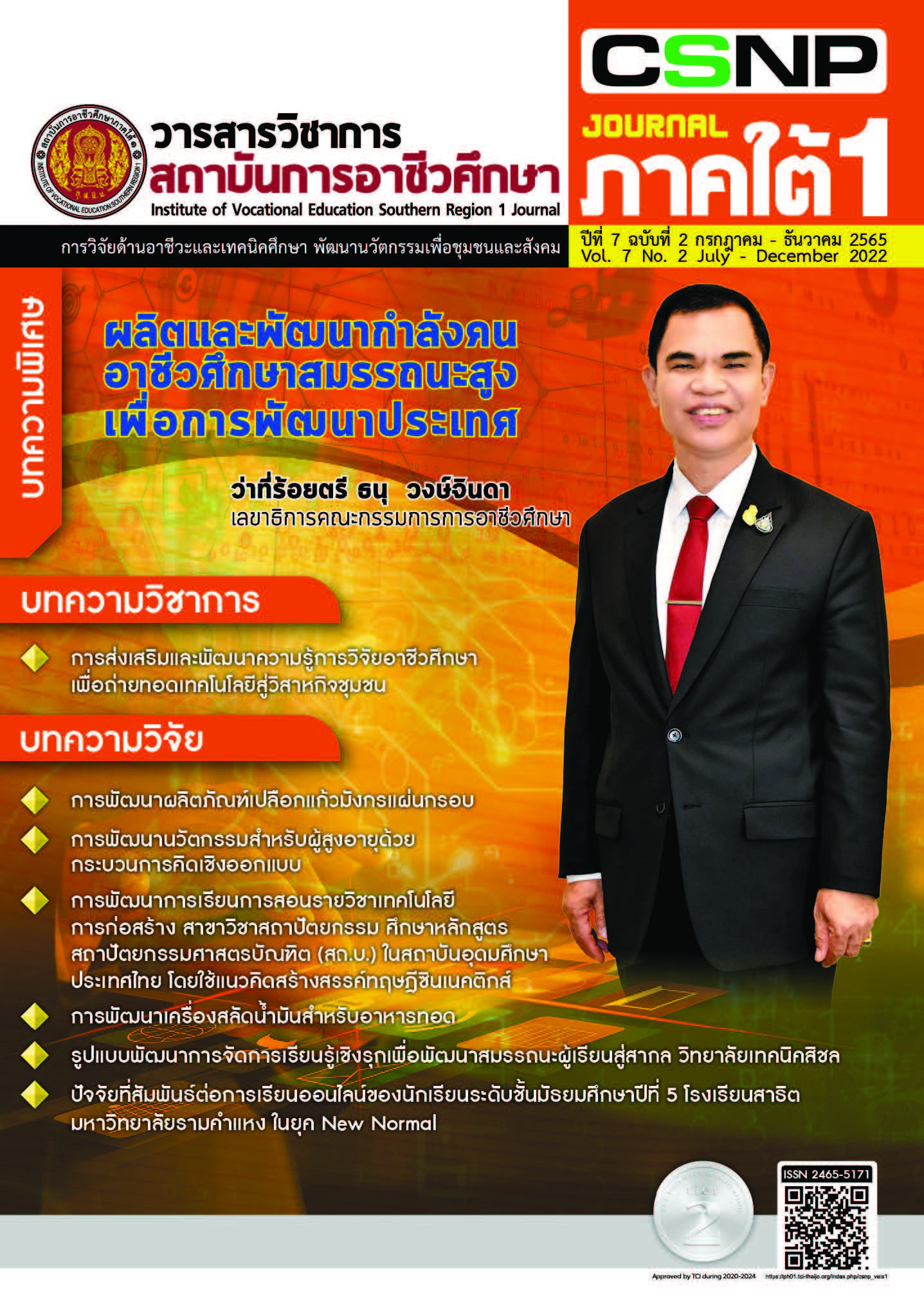Development of a Printer Showing Body-mass Index and Automatic Queuing of Health Care Recipients with ID Card Information
Keywords:
Queue Card Printer, Medical Work, ID CardAbstract
The objectives of this research were to: 1) develop a printer showing body- mass index and automatic queuing of health care recipients with ID card information; 2) determine the efficiency of a printer showing body mass index and automatic queuing of health care recipients with ID card information; and 3) study the satisfaction of the users towards the printer showing body- mass index and automatic queuing of health care recipients with ID card information. The research model was an experimental method based on the concept of a queuing system using the information in the ID card. The research was conducted at Nawamin 9 Hospital and 43 Health Service Centers, Minburi District, Bangkok. The sample group consisted of 30 medical personnel and people who came to use the services derived by simple random sampling. The research tools included the printer automatically displaying the body- mass index and queue of health care recipients with ID card information; the hospital waiting system; the efficacy record form; and the satisfaction assessment form. The data was analyzed using statistical values, percentages, and means.
The results of the research showed that 1) body- mass index display printer and automatic queue with microcontroller circuit system would take the height and weight values to process as numeric data. The first and last name information read from the chip on the ID card was processed by a computer and displayed on the screen. Then, the queue card was printed on the printer with the first name, last name, weight, height, body- mass index (BMI), queue order, date, and time. 2) The efficiency of the printer showing body- mass index and automatic queuing of health care recipients with ID card information was more accurate and 8.55 min faster than the existing hospital waiting system. 3) The overall average of the users’ satisfaction was at a high level.
References
ธรรมรัตน์ มะโรหบุตร. (2561). ยุทธศาสตร์นโยบายการเป็นศูนย์กลางทางการแพทย์ (Medical Hub) กับสถานการณ์ที่สะท้อนผลกระทบต่อระบบสุขภาพของประเทศไทย. วารสารคุณภาพชีวิตกับกฎหมาย, 14(2), 27-41.
พรพิมล ชัยวุฒิศักดิ์ วริยา ยังไว วีรชัย มีสัตย์ และศุภวิชญ์ สมเกียรติวีระ. (2563). การจำลองระบบแถวคอยเพื่อเพิ่มประสิทธิภาพการให้บริการแผนกผู้ป่วยนอก: กรณีศึกษาโรงพยาบาลเมืองปาน จังหวัดลำปาง. วารสารวิทยาศาสตร์ลาดกระบัง, 29(1), 10-23.
คัทลิยา วสุธาดา. (2560). การพัฒนารูปแบบการดำเนินงานเพื่อลดระยะเวลารอคอยการรับบริการในผู้ป่วยโรคเรื้อรัง ศูนย์สุขภาพชุมชนเมืองท่าช้าง จังหวัดจันทบุรี. วารสารวิทยาลัยพยาบาลพระปกเกล้า จันทบุรี, 28(1), 80-89.
รัตนสุดา สุภดนัยสร ธีรถวัลย์ ปานกลาง และจุรีพร ศรีชุมแสง. (2562). การออกแบบและสร้างระบบวัดดัชนีมวลกาย (BMI) อัตโนมัติแสดงผลผ่านเครือข่ายอินเทอร์เน็ต. วารสารวิชาการเทพสตรี I-TECH, 14(2), 73-85.
ดอนสัน ปงผาบ. (2563). ไมโครคอนโทรลเลอร์ Aduino. กรุงเทพมหานคร: สมาคมส่งเสริมเทคโนโลยี (ไทย-ญี่ปุ่น).
ธนวัฒน์ จิรรัตนโสภา และสนธยา วงศ์มุสา. (2559). เครื่องชั่งน้ำหนักและวัดส่วนสูงแบบกึ่งอัตโนมัติที่มีเครื่องพิมพ์สลิป. ปริญญานิพนธ์หลักสูตรวิศวกรรมศาสตรบัณฑิต สาขาวิชาวิศวกรรมอิเล็กทรอนิกส์ มหาวิทยาลัยเทคโนโลยีราชมงคลศรีวิชัย, สงขลา.
กิตติคุณ แสงนิล และประสพชัย พสุนนท์. (2561). ความน่าเชื่อถือ ความถูกต้อง ความแม่นยำ และความเที่ยงตรง ความสอดคล้องในวิธีการและความคลาดเคลื่อนจากการวัด ของการวิจัยทางด้านสรีรวิทยาการออกกำลังกาย. Veridian E-Journal สาขาวิทยาศาสตร์และเทคโนโลยี, 5(6), 1-19.
สุเมธา ศรีละคร และสมบัติ สินธุเชาวน์. (2560). การประยุกต์ใช้ทฤษฎีแถวคอยและการจำลองแบบปัญหาเพื่อลดเวลารอคอยในการรับบริการของผู้ป่วยนอกของโรงพยาบาลวารินชำราบ. การประชุมวิชาการข่ายงานวิศวกรรมอุตสาหการ วันที่ 12-15 กรกฎาคม 2560 มหาวิทยาลัยเชียงใหม่, เชียงใหม่.
อัจฉราวรรณ ศรสว่าง. (2564). ผลการใช้แนวปฏิบัติลดระยะเวลารอคอยแผนกผู้ป่วยนอกโรงพยาบาลพระนารายณ์มหาราช. วารสารสุขภาพและสิ่งแวดล้อมศึกษา, 6(4), 181-189.
Downloads
Published
Issue
Section
License
Copyright (c) 2022 Institute of Vocational Education Southern Region 1 Journal

This work is licensed under a Creative Commons Attribution-NonCommercial-NoDerivatives 4.0 International License.



